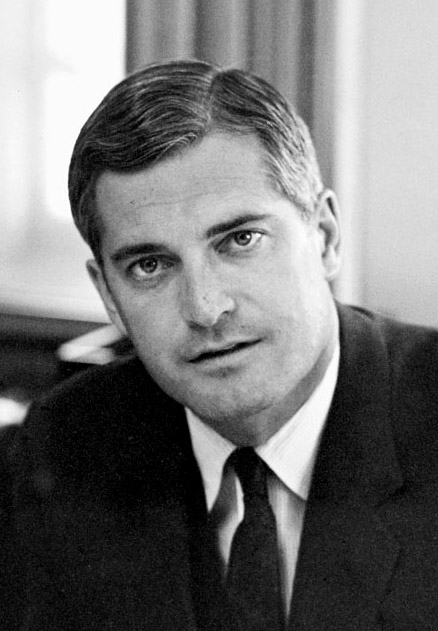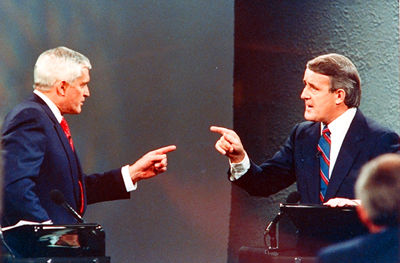John Napier Turner, PC, CC; politician, lawyer, prime minister, athlete (born in Richmond, England, 7 June 1929; died 19 September 2020 in Toronto, ON). John Turner is best known for his early political service as federal justice minister (1968–72) and finance minister (1972–75) in the cabinet of Prime Minister Pierre Trudeau, and for the 1988 election battle with Brian Mulroney over free trade. Turner's 11-week term as prime minister in 1984 is the second shortest in Canadian history, after Sir Charles Tupper (10 weeks).

John Turner speaking at Arizona State University in Glendale, Arizona, 7 February 2018.
Early Years and Athletics
Following the death of his father, Leonard Hugh Turner, John — at about the age of four — accompanied his Canadian-born mother Phyllis [née Gregory] to Canada in 1932. The family settled in Ottawa where Phyllis, an economist, became a senior federal civil servant. After attending Ottawa private schools, Turner moved to British Columbia with his mother and stepfather, Frank Ross, at the end of the Second World War. (Ross became lieutenant-governor of BC in 1955, and Phyllis served as chancellor of the University of British Columbia).
Turner studied political science at UBC, where he excelled in athletics. In 1947, he became the fastest man in Canada, setting the Canadian record for the 100-yard dash (9.8 seconds). The following year he ran his personal best (9.6 seconds) and qualified for the 1948 Olympic Summer Games. However, he was unable to attend the Games after injuring his knee in a car accident.
Turner went on to study at the University of Paris, and at Oxford University, where he earned his law degree in 1952 as a Rhodes Scholar. He returned to Canada and joined a Montreal law firm, qualifying as a lawyer in Quebec in 1954. Turner married Geills Kilgour in 1963. They had four children together.
Federal Politics: 1962–74
Recruited by Prime Minister Lester Pearson as a Liberal candidate in Montreal, Turner was elected to the House of Commons in 1962 (and re-elected in 1963 and 1965). When the redistribution of federal ridings abolished his seat, he moved in 1968 to an Ottawa constituency.
He first entered the cabinet in a post-election shuffle by Pearson in December 1965. He served in minor offices until becoming minister of consumer and corporate affairs in December 1967.

In 1968, Turner ran for the Liberal leadership following Pearson's resignation. Although he lost to Pierre Trudeau,
Turner made a respectable showing as an "anti-establishment" party candidate and as the most prominent younger English-language minister. Trudeau appointed him justice minister in July 1968. Turner held the position until January 1972. In this capacity,
he sponsored Criminal Code reform and special legislation that followed the 1970 October Crisis.
In 1972, Trudeau transferred Turner to the Department of Finance. When the Trudeau government lost its parliamentary majority in November 1972, Turner found it necessary to tailor policy to the demands of popularity; tax reductions and pension increases followed. The government still ran a surplus, both in 1973 and 1974, but the overall effect of its policy was to stimulate inflation.
After the Trudeau government regained its majority — in an election triggered by the defeat of Turner's May 1974 budget in the House of Commons — Turner concentrated on restraining inflation. However, he also wanted to move on from the finance portfolio.
Break with Trudeau
In 1975, reports surfaced in the press that Turner was considering quitting both the Trudeau government and federal politics entirely. He and the prime minister discussed the issue in July; Trudeau suggested that Turner take another cabinet post or remain in the government for at least another year. The meeting ended without a clear decision.
The two met again in early September. By this time, Turner had decided that the Trudeau government had an unrealistic assessment of the country’s economic situation and the mood of the voters. He felt the prime minister had not given Turner's financial policies sufficient support and was not providing effective leadership. Perhaps most importantly, Turner saw no possibility of taking over the leadership of the Liberal Party. On 9 September, he submitted his letter of resignation to the Prime Minister’s Office.
Turner’s sudden departure from cabinet was a bombshell that dominated national headlines. Trudeau’s supporters presented Turner’s resignation as an act of disloyalty; others saw Turner as the wronged party. The media praised Turner’s work in the ministries of justice and finance. The consensus was that he had resigned because he could not convince his colleagues to reduce government spending.
Turner's resignation hurt the federal Liberal Party. It also may have been a factor in Ontario Liberal leader Robert Nixon’s provincial election loss to Progressive Conservative premier Bill Davis that September. There was subsequent speculation that Turner might seek the leadership of the Ontario Liberal party; or even change political colours and make a bid for the leadership of the federal Progressive Conservatives after the resignation of Robert Stanfield. However, in February 1976, Turner quit politics altogether. He joined a large Toronto law firm, as well as the boards of directors of a number of Canadian companies.

Prime Minister
Turner declined to put his name forward as a candidate for the Liberal leadership in 1979 after Pierre Trudeau's first, brief resignation. A leadership contest was never held, due to Trudeau’s abrupt return ahead of the 1980 election. (See Elections of 1979 and 1980.)
Four years later, with the announcement of Trudeau's resignation, Turner decided to try for the leadership. He won on the second ballot on 16 June 1984, defeating runner-up Jean Chrétien. As leader of the governing Liberal party, Turner automatically became Canada’s 17th prime minister on 30 June. He was not required to call an election until 1985. But with the Liberals leading in the polls, he decided to have Parliament dissolved on 9 July. A federal election was called for 4 September.
1984 Election
The Liberal lead slipped as Turner made several major gaffes during the summer campaign. He was criticized for wanting to create jobs via “make work projects” — a 1970s label that was indicative of Turner's outdated campaign style and conduct. He was caught on camera patting Liberal Party president Iona Campagnolo on the posterior. He tried to defend the act as a friendly gesture, failing to realize that many women saw it as condescending.
Most damaging to Turner’s campaign was the Liberal legacy of patronage. Before leaving office, Pierre Trudeau had recommended that Governor General Jeanne Sauvé appoint more than 200 Liberals to government patronage posts. As prime minister, Turner not only failed to cancel the appointments, but also added more than 70 of his own. Canadians were outraged. In a televised English-language debate, Progressive Conservative leader Brian Mulroney all but finished the Liberals’ chances of re-election when he told a visibly flustered Turner: “You had an option, sir. You could have said, ‘I am not going to do it. This is wrong for Canada, and I am not going to ask Canadians to pay the price.’ You had an option, sir — to say ‘no’ — and you chose to say ‘yes’ to the old attitudes and the old stories of the Liberal Party. That sir, if I may say respectfully, that is not good enough for Canadians.”
The Liberals suffered a massive defeat. They were reduced to only 40 seats in the House of Commons and lost many ridings in their traditional stronghold of Quebec. Turner won his own seat in Vancouver Quadra. He left office as prime minister on 17 September, and began four years as leader of the Opposition.
1988 Election
Amid much internal discord, Turner managed to rebuild and revitalize the Liberal Party. He was reconfirmed as leader at the party convention of 1986. The Liberals were again leading in the polls by 1987.
The defining issue of the 1988 election was the free trade agreement that the government of Prime Minister Brian Mulroney was negotiating with the United States. ( See NAFTA.) The agreement would abolish most tariffs at the Canada-USA border and establish a new process for dealing with trade disputes. Corporate interests solidly supported the agreement. Opposing it were labour unions, the arts community, and Canadians who feared that their national sovereignty was at stake.
Turner accused Mulroney of selling out Canada to the United States and declared that his battle against the agreement was “the fight of my life.” The Liberals more than doubled their seats in the election, taking 83 ridings. However, Mulroney won a second majority government and the free trade agreement was ratified. Turner resigned as leader of the Liberal Party in 1990; he was replaced by Jean Chrétien.

Post Political Career
Turner kept his seat in Parliament until 1993, though he was rarely seen in the Commons. In 1990, he returned to private practice, this time as a lawyer at Miller Thomson LLP. He eventually became head of the law firm’s scholarships program. He also sat on the boards of several corporations.
In 1994, Turner was made a Companion of the Order of Canada. In 2004, he was a member of the Canadian delegation that monitored the Ukrainian presidential election runoff vote. He participated with other former prime ministers in the television reality series Canada’s Next Great Prime Minister in 2008. In 2012, Turner was awarded the Queen Elizabeth II Diamond Jubilee Medal for Canada.
A state funeral was planned for Turner following his death on 18 September 2020 at the age of 91; however, the ongoing COVID-19 pandemic was expected to complicate those plans.


 Share on Facebook
Share on Facebook Share on X
Share on X Share by Email
Share by Email Share on Google Classroom
Share on Google Classroom


